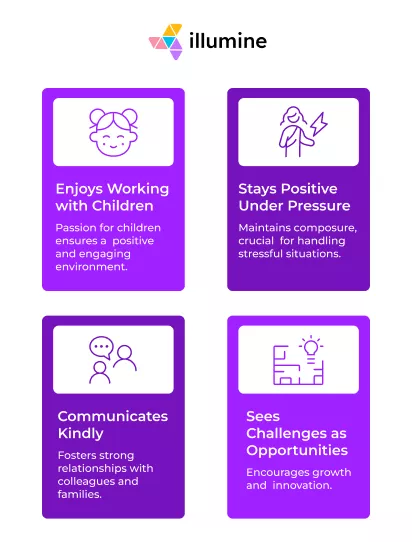No matter how thoughtful your curriculum or how beautiful your classrooms, the heart of a preschool lies in its people. A school’s success is built on the quality, consistency, and spirit of its team. The adults who work together every day create the atmosphere that children and families feel from the moment they walk in.
A strong team does more than keep things running. It sets the tone for trust, stability, and joy. Every decision about hiring and leadership shapes how your school will grow and what kind of community it will become.
11 Preschool Teacher Recruitment Strategies
1. Start with Your Vision For Preschool Hiring
Before writing a single job post, pause and picture the kind of school you want to build.
Is it a small, family-like setting where everyone helps with everything? Or a larger program with clearly defined departments and specialists? The answer shapes your structure, the people you hire, and the tone of your culture.
Your vision guides how you define responsibilities, build leadership roles, and plan for the future. The most successful schools grow from a shared sense of purpose and respect for how young children learn. The adults you bring together will live that vision each day through their relationships with children, families, and one another.
2. Core Roles and Typical Structure
Behind every peaceful classroom is a well-organized team. Understanding key roles early helps you plan clearly, prevent burnout, and set fair expectations. It also helps you budget wisely and build a structure that can expand as your enrollment grows.
Most preschools include some combination of the following positions:
Smaller schools often combine these roles. Once your enrollment approaches 80 to 100 children, you’ll likely need dedicated administrative and admissions staff to keep operations smooth.
3. Determining Staffing Levels
Each state or region sets minimum adult-to-child ratios. These numbers are not just licensing requirements. They reflect how much attention each child receives and how safe and supported your classrooms will feel.
Typical ranges include:
- Infants: 1 adult per 4 children
- Toddlers: 1 adult per 5–8 children
- Preschoolers (ages 3–5): 1 adult per 10–15 children
Many quality programs choose to staff slightly above those minimums. This allows for more individualized attention, coverage during absences, and a calmer atmosphere as routines settle in. Ratios also affect teacher satisfaction. When adults are not overstretched, they can focus on nurturing and observing rather than simply managing.
4. Hiring for Character and Fit

Degrees and certifications matter, but temperament and attitude are what sustain a great team. Children mirror the emotional energy of the adults around them. Calm, patient teachers create calm, happy classrooms.
Look for people who:
- Genuinely enjoy working with young children
- Stay steady and positive under pressure
- Communicate kindly with colleagues and families
- See challenges as opportunities to learn
During interviews, go beyond qualifications. Ask questions that reveal how candidates act in real situations.
For example:
“How would you help a child who refuses to join a group activity?”
“What would you say to a parent who feels worried or defensive?”
These stories tell you far more about a person’s heart and instincts than their résumé ever could.
5. Building a Reliable Hiring Pipeline
Finding qualified staff has become one of the hardest tasks in early education. The best schools treat hiring as an ongoing process, not a seasonal scramble.
You can build a strong pipeline by:
- Encouraging current parents and volunteers to take on part-time or assistant roles
- Partnering with local colleges to host interns or student teachers
- Using early childhood associations for job boards and networking events
- Welcoming career changers who bring maturity and reliability, paired with good training
Offer trial days or short-term contracts before confirming full-time hires. These opportunities allow both sides to see whether the values, rhythm, and expectations truly align.
6. Interviewing and Onboarding Basics

A thoughtful interview and onboarding process sets the tone for every new hire’s journey. Even the best educators need time and guidance to feel part of your school’s rhythm.
During interviews, focus on both skill and fit. Let candidates observe a classroom, meet other staff, or share how they handle common preschool scenarios. The goal is not to intimidate but to understand how they naturally respond in real settings.
Once hired, create a warm, structured onboarding plan. Include a tour of routines, introductions to families, and shadow days with experienced teachers. Share your school’s philosophy, communication norms, and expectations clearly from day one.
When onboarding is intentional, new staff settle faster, feel supported, and contribute to your school culture with confidence.
7. Clear Roles and Expectations
Clarity builds trust. Each position should have a written description that outlines:
- Core duties and daily routines
- Who supervises and evaluates the role
- Expected standards of communication and conduct
- Opportunities for growth and feedback
When everyone knows their responsibilities and boundaries, teamwork becomes easier. Misunderstandings are fewer, and accountability feels fair.
Sample Description of a Preschool Teacher
8. Compensation and Living Wages
Staff compensation is both an ethical duty and a strategic choice. The way you pay your team reflects what you value most.
To attract and retain great educators:
- Research local salary benchmarks for similar programs
- Plan your financial model to ensure each role earns a living wage in your community
- Offer benefits when possible: paid time off, health stipends, tuition discounts, or retirement contributions
- Recognize and celebrate excellence with small bonuses or public appreciation
Underpaying educators leads to burnout and turnover. In the long run, the costs of constant rehiring far outweigh the investment in fair pay and loyalty.
9. Professional Development and Retention
Retention begins with respect. Teachers stay where they feel valued, supported, and able to grow. A stable team brings emotional security to children and builds parent trust. It also protects your school’s reputation and saves significant time and resources spent on recruitment.
Support your team with:
- Paid professional development days or stipends for workshops
- Training in child development, classroom management, and curriculum methods
- Regular observation and feedback focused on growth, not criticism
- Mentorship programs pairing new teachers with experienced ones
When teachers stay, families stay. Consistency creates trust, and trust builds a strong brand.
10. Communication and School Culture
Healthy school culture grows from open, respectful communication. Keep conversations honest, frequent, and two-way.
- Hold weekly team meetings for collaboration and planning.
- Stay accessible and approachable as a leader.
- Encourage constructive feedback in all directions.
- Celebrate milestones and successes publicly.
When adults work together with mutual respect and joy, children sense it immediately. A calm, positive staff creates a calm, happy school.
11. Leadership and Longevity
Great leaders in early education guide more than they manage. They model composure, empathy, and clear purpose.
A strong director or head of school provides consistency that families depend on. They help teachers grow, navigate challenges with patience, and keep the vision of the school alive year after year.
Leadership longevity builds trust. When parents see familiar faces and confident leadership, they know their children are in steady hands.
Final Thoughts
Building a thriving preschool team is a long-term commitment, not a project you check off once the hiring is done. Every phase, from defining your vision to mentoring your staff, feeds into the next.
As you move forward, keep these guiding ideas in mind:
- Your vision is your anchor. Every role, routine, and relationship should reflect the kind of environment you want children to grow up in.
- Hire for heart as much as for skill. Degrees matter, but warmth, patience, and teamwork shape the culture families feel.
- Clarity creates confidence. When people know their roles, expectations, and goals, they work together with ease and accountability.
- Fair pay and growth go hand in hand. A sustainable school values its educators, not just through words, but through wages, benefits, and real opportunities to learn.
- Culture doesn’t happen by accident. Keep communication open, celebrate progress, and nurture relationships every day.
- Leadership sets the tone. Strong, steady leaders bring calm, consistency, and inspiration that ripple through classrooms and families alike.
When you keep revisiting these essentials such as vision, hiring, clarity, compensation, growth, culture, and leadership, your school not only functions well but flourishes. The team you build today will shape your school’s spirit for years to come, leaving an imprint on every child and family who walks through your doors.









.webp)